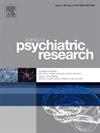Prenatal stress alters mouse offspring dorsal striatal development and placental function in sex-specific ways
IF 3.7
2区 医学
Q1 PSYCHIATRY
引用次数: 0
Abstract
Prenatal stress is a risk factor for neurodevelopmental disorders (NDDs), including autism spectrum disorder (ASD). However, how early stress modification of brain development contributes to this pathophysiology is poorly understood. Ventral forebrain regions such as dorsal striatum are of particular interest: dorsal striatum modulates movement and cognition, is altered in NDDs, and has a primarily GABAergic population. Here, we examine effects of prenatal stress on adult movement, cognition, and dorsal striatum neurobiology in mice using striatal-dependent behavioral assays, immunohistochemistry, embryonic ventral forebrain transcriptomics, and placental transcriptomics. We found prenatal stress affected adult procedural, habit, and reversal learning in sex-specific ways. Stress also increased adult dorsal striatal GABAergic neurons – an effect largely driven by males. We sought to examine the developmental origins of these adult brain changes. We found similar sex-specific dorsal striatal cellular changes in earlier points of development. The dorsal striatum primordium--embryonic ventral forebrain—showed that prenatal stress increased DNA replication and cell cycle pathways in male but not female transcriptomics and cellular biology. Unique signatures may have arisen from male-female placental differences. Stress-induced placental transcriptomics showed upregulated morphogenesis pathways in males while females downregulated morphogenic, hormonal, and cellular response pathways. Our findings suggest that prenatal stress could affect placenta function and also alter the GABAergic population of dorsal striatum differentially between the sexes.
产前应激以性别特异性的方式改变小鼠后代背纹状体发育和胎盘功能。
产前压力是神经发育障碍(ndd)的危险因素,包括自闭症谱系障碍(ASD)。然而,大脑发育的早期应激修饰如何促进这种病理生理学尚不清楚。腹侧前脑区域,如背纹状体是特别感兴趣的:背纹状体调节运动和认知,在ndd中发生改变,并具有主要的gaba能群体。在这里,我们使用纹状体依赖的行为分析、免疫组织化学、胚胎腹侧前脑转录组学和胎盘转录组学研究了产前应激对小鼠成年运动、认知和背纹状体神经生物学的影响。我们发现产前压力以性别特异性的方式影响成人的程序、习惯和逆向学习。压力也增加了成人背纹状体gaba能神经元——这一效应主要由男性驱动。我们试图研究这些成人大脑变化的发育起源。我们发现类似的性别特异性背纹状体细胞变化在早期的发育点。背纹状体原基(胚胎的腹侧前脑)表明,产前应激增加了雄性的DNA复制和细胞周期通路,但没有增加雌性的转录组学和细胞生物学。独特的特征可能源于男女胎盘的差异。应激诱导的胎盘转录组学显示,男性的形态发生通路上调,而女性的形态发生通路、激素通路和细胞反应通路下调。我们的研究结果表明,产前应激会影响胎盘功能,也会改变背纹状体gaba能种群的性别差异。
本文章由计算机程序翻译,如有差异,请以英文原文为准。
求助全文
约1分钟内获得全文
求助全文
来源期刊

Journal of psychiatric research
医学-精神病学
CiteScore
7.30
自引率
2.10%
发文量
622
审稿时长
130 days
期刊介绍:
Founded in 1961 to report on the latest work in psychiatry and cognate disciplines, the Journal of Psychiatric Research is dedicated to innovative and timely studies of four important areas of research:
(1) clinical studies of all disciplines relating to psychiatric illness, as well as normal human behaviour, including biochemical, physiological, genetic, environmental, social, psychological and epidemiological factors;
(2) basic studies pertaining to psychiatry in such fields as neuropsychopharmacology, neuroendocrinology, electrophysiology, genetics, experimental psychology and epidemiology;
(3) the growing application of clinical laboratory techniques in psychiatry, including imagery and spectroscopy of the brain, molecular biology and computer sciences;
 求助内容:
求助内容: 应助结果提醒方式:
应助结果提醒方式:


